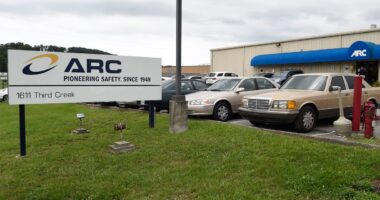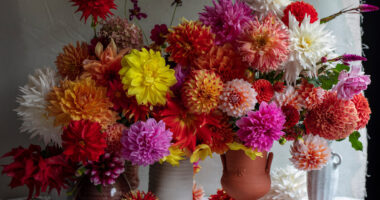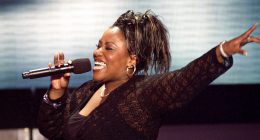Eleanor Jacobs, who stumbled upon a pair of odd-looking shoes in Denmark and, with her husband, Raymond, created a short-lived phenomenon by selling them in the United States as Earth Shoes, died on Aug. 25 at her home in Litchfield, Conn. She was 91.
Her daughter Susan Jacobs said the cause was congestive heart failure.
In 1969, while she and her husband were vacationing in Denmark, Ms. Jacobs’s chronic back pain increased from all the walking she had been doing. She found unexpected salvation with a pair of negative-heel shoes she found at a store in Copenhagen.
Originally called Anne Kalso Minus-Heels, named after the Danish yoga instructor who had designed them, they featured a wide toe box and a sole that was thicker in the front than in the back.
As the family continued to Norway, Ms. Jacobs was so pleased with her new purchase that Mr. Jacobs, who was a commercial photographer at the time, suggested they try to sell the shoes in the United States.
When they called Ms. Kalso, she was happy that the Jacobses were not in the shoe business — she had rejected earlier offers from conventional shoe manufacturers — and that Mr. Jacobs wanted to market the shoes as part of a back-to-nature movement.
On April 22 the next year, the couple opened a store devoted to their homely import in their street-level brownstone near Union Square in Manhattan. Later that morning, they noticed a stream of young people, many of them hippies, passing their store toward Union Square Park, and Ms. Jacobs asked one of them what was going on.
“Hey, man, it’s Earth Day! There is a love-in-down the street in the park,” she recalled a young man telling her when she wrote about that day for the Litchfield Enquirer in 2008. “Come and join us.”
The Jacobses did not join them. Instead, they renamed the shoes.
“I turned to look at my husband, who had a eureka look on his formerly worried face,” Ms. Jacobs wrote. “‘Ellie, that’s it,’ he screamed at me. ‘We’ll call them Earth Shoes.’”
He scribbled the name in black crayon on a piece of cardboard and placed it in the store window. Customers quickly began buying the shoes.

It was the start of an exciting but brief business odyssey for the couple, who were not footwear experts and had never run a business. After making a deal with Ms. Kalso for North American distribution rights (which would expand to world rights, except in Denmark), they licensed and supplied more than 100 stores. Demand grew so quickly that the Jacobses opened a factory in 1973 in Middleboro, Mass., to augment their Danish imports. In all, they would sell millions of pairs of Earth Shoes.
Despite its peculiar look, the Earth Shoe became popular beyond the counterculture set, largely because of the help it was said to offer to aching backs and feet (a point of disagreement among podiatrists and other foot experts). The shoes were featured in The Whole Earth Catalog and on Time magazine billboards in Grand Central Terminal.
“The ugly duckling shoe seems to have caught on like ‘The Exorcist,’” The Times reported in 1974. “And indeed, the line at the cash counter on Monday would have been envied by many theater managers. Army parkas and bluejeans cued up with mink and Brooks Brothers tweeds to pay for their shoes and walked out happily with purchases in burlap bags.”
The Times also reported that a chauffeur pulled up at the Jacobses’ store on East 17th Street one day, carrying a penciled outline of the actor Walter Matthau’s feet. He was shooting a film in Manhattan, and his feet were hurting. Six pairs were sent back to him. He bought two.
Around that time, the Jacobses added new styles, including an athletic shoe and a hiking boot, to their staples of walking shoe and sandals. Ms. Jacobs said they needed to appeal to a widening customer base.
“The people who are buying our shoes are no longer leftover flower children from the ’60s,” she told The Washington Post in 1975. “They’re worn by a cross section of American people now. So we had to develop a new line of shoe with that in mind.”
Eleanor Cohen was born on July 25, 1929, in the Bronx to immigrants from Lodz, Poland. Her father, Samuel, worked in the garment industry; her mother, Mary (Praw) Cohen, was a homemaker.
After graduating from high school in 1946, Eleanor worked as a secretary at Teachers College at Columbia University for a few years before moving on to the J. Walter Thompson advertising agency, where she was a secretary and copywriter in training until 1958. During that time, she also began to study painting with the Russian-born artist Evsa Model. She married Mr. Jacobs in 1955.
Over the next decade, she raised their two daughters while Raymond built his career as a fine art and commercial photographer, whose work appeared in Fortune, Esquire, Harper’s Bazaar, Redbook and Ladies’ Home Journal, as well as in advertising campaigns for Campbell’s Soup, Pan Am and Johnson & Johnson. She often accompanied her husband on his assignments.
By 1977, the Jacobses’ seven-year Earth Shoe sojourn was over. Hurt by knockoffs and by questions about the shoe’s purported health benefits, the company was burdened by debt and cash flow problems, and filed for Chapter 11 bankruptcy protection. (A new company, Earth Inc., revived what it calls Earth Kalso Shoes in 2001.)
The bank that had lent the company money “didn’t trust us, nor our flower children, nor our unconventional marketing strategy despite our steady growth and profits,” Ms. Jacobs wrote in The Litchfield Enquirer in 2000.
In addition to her daughter Susan, Ms. Jacobs is survived by another daughter, Laura Pavlick, and two grandchildren. Her husband died in 1993.
While running the Earth Shoe business, Ms. Jacobs studied art history at New York University’s Gallatin School of Individualized Study (she received her bachelor’s degree in 1979). The Jacobses opened the Art Appreciation Gallery in the former Earth Shoe space in 1978. She later worked as an administrator at Sotheby’s and Hirschl & Adler Galleries, before becoming an art consultant.
She also kept a decades-rich supply of Earth Shoes — sandals, oxfords and shearling-lined winter boots — that she wore nearly to the end of her life.
Source: | This article originally belongs to Nytimes.com








